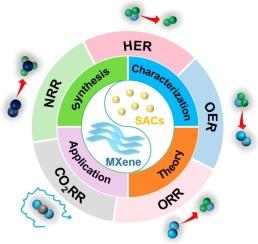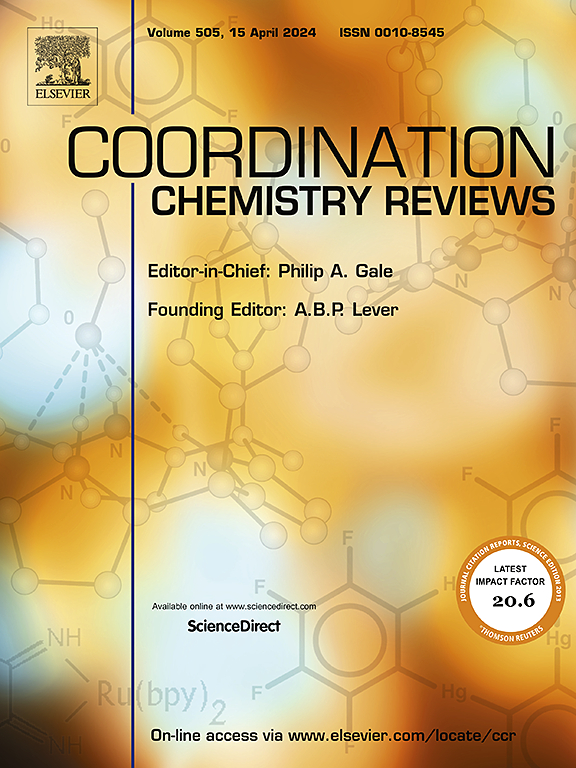电催化用mxeni基单原子催化剂的研究进展
IF 23.5
1区 化学
Q1 CHEMISTRY, INORGANIC & NUCLEAR
引用次数: 0
摘要
单原子催化剂由于其高原子利用率、独特的电子结构和不饱和配位环境而具有优异的电催化活性。然而,在SACs的制备和电催化过程中,单原子本身高的表面自由能容易聚集成纳米颗粒或团簇,从而导致催化活性的衰减。过渡金属碳化物/氮化物(MXene)作为一种新型二维材料,具有比表面积大、锚定位点丰富、导电性好等优点,是固定单原子的理想载体。在本文中,我们首先总结了MXene作为单原子载体的优点。随后,系统阐述了基于mxene的SACs的合成策略和鉴定方法。然后,我们从原位分析和理论计算两方面概括了基于mxene的SACs的电催化机理。此外,对mxene基SACs催化剂的电催化应用进行了广泛的探索,包括析氢反应(HER)、析氧反应(OER)、氧还原反应(ORR)、CO2还原反应(CO2RR)和氮还原反应(NRR)。最后,我们提出了一些前瞻性的观点和未来的发展方向,旨在为基于mxeni的高活性SACs的合理设计和精确制备提供专业和有针对性的指导。本文章由计算机程序翻译,如有差异,请以英文原文为准。


Advances in MXene-based single-atom catalysts for electrocatalytic applications
Single-atom catalysts (SACs) possess excellent electrocatalytic activity due to their high atom utilization, unique electronic structure and unsaturated coordination environment. However, the intrinsically high surface free energy of single atoms tends to aggregate into nanoparticles or clusters during the preparation and electrocatalysis of SACs, thus endowing the attenuation of catalytic activity. Transition metal carbides/nitrides (MXene), as a new type of two-dimensional material, is an ideal carrier for fixing single atoms due to its large specific surface area, ample anchoring sites and excellent conductivity. In this review, we first summarize the advantages of MXene as a single atom carrier. Subsequently, the synthesis strategies and identification methods of MXene-based SACs are systematically explicated. Afterwards, we encapsulate the electrocatalytic mechanism of MXene-based SACs from both in situ analysis and theoretical calculations. Moreover, the electrocatalytic applications of MXene-based SACs catalysts are explored extensively, including hydrogen evolution reaction (HER), oxygen evolution reaction (OER), oxygen reduction reaction (ORR), CO2 reduction reaction (CO2RR) and nitrogen reduction reaction (NRR). Finally, we put forward some forward-looking perspectives and future development directions, aiming to provide professional and targeted guidance for the rational design and precise preparation of highly active MXene-based SACs.
求助全文
通过发布文献求助,成功后即可免费获取论文全文。
去求助
来源期刊

Coordination Chemistry Reviews
化学-无机化学与核化学
CiteScore
34.30
自引率
5.30%
发文量
457
审稿时长
54 days
期刊介绍:
Coordination Chemistry Reviews offers rapid publication of review articles on current and significant topics in coordination chemistry, encompassing organometallic, supramolecular, theoretical, and bioinorganic chemistry. It also covers catalysis, materials chemistry, and metal-organic frameworks from a coordination chemistry perspective. Reviews summarize recent developments or discuss specific techniques, welcoming contributions from both established and emerging researchers.
The journal releases special issues on timely subjects, including those featuring contributions from specific regions or conferences. Occasional full-length book articles are also featured. Additionally, special volumes cover annual reviews of main group chemistry, transition metal group chemistry, and organometallic chemistry. These comprehensive reviews are vital resources for those engaged in coordination chemistry, further establishing Coordination Chemistry Reviews as a hub for insightful surveys in inorganic and physical inorganic chemistry.
 求助内容:
求助内容: 应助结果提醒方式:
应助结果提醒方式:


